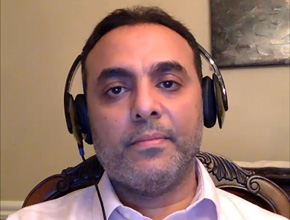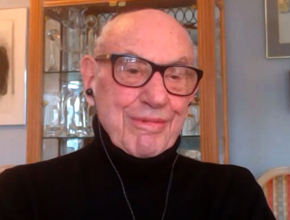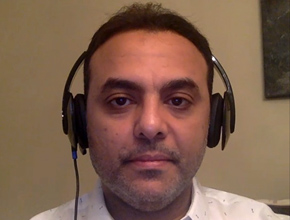Dr Imran Satia, assistant professor in the Division of Respirology at McMaster University and researcher of chronic cough, joins Dr James Douketis to discuss the practical relevance of the current definitions and management guidelines in chronic cough.
References
Morice AH, Millqvist E, Bieksiene K, et al. ERS guidelines on the diagnosis and treatment of chronic cough in adults and children. Eur Respir J. 2020 Jan 2;55(1). pii: 1901136. doi: 10.1183/13993003.01136-2019. Print 2020 Jan. PubMed PMID: 31515408; PubMed Central PMCID: PMC6942543.American College of Chest Physicians. Guidelines & Consensus Statements. https://www.chestnet.org/Publications/CHEST-Publications/Guidelines-Consensus-Statements. Accessed March 25, 2020.
James Douketis, MD: Welcome to another edition of McMaster Perspective, which this time complements the upcoming Publications of the Week [see Publications of the Week, March 30]. Today we’re going to be talking about the assessment and management of chronic cough. It’s my pleasure to have with us to speak about this Doctor Imran Satia, assistant professor in McMaster University’s Department of Medicine, Division of Respirology. Welcome, Imran.
Imran Satia, MD, PhD: Thank you for inviting me and having me over.
James Douketis: Let’s dive right in. Chronic cough: how do you define that for a general audience?
Imran Satia: At the moment the current guidelines by the European Respiratory Society, the American College of Chest Physicians, and the American Thoracic Society have made a diagnosis of chronic cough based on a daily persistent cough that has been lasting at least for the last 8 weeks, or more. That’s the current definition that we’re using.
James Douketis: Can you describe some of the key features of chronic cough and what clinicians should be looking for?
Imran Satia: Chronic cough generally tends to affect around 10% of the general population. It peaks in the ages of around 50 to 60 years. It occurs twice as frequently in women than in men, and we don’t fully understand why. It can be associated with lots of medical conditions, such as asthma, chronic obstructive pulmonary disease (COPD), in some rare cases bronchiectasis, but also gastrointestinal diseases (GI), such as reflux, and nasal disease. In many cases there’s no identified cause and we call it unexplained chronic cough. In cases when there is an associated cause we often call it refractory chronic cough to certain treatments.
James Douketis: Interesting.
The European Respiratory Society guidelines talk about cough hypersensitivity syndrome. For me, and probably for many other clinicians, that’s a bit of an unknown entity. Can you articulate what that refers to from a clinical standpoint?
Imran Satia: This is something that has been thought and written about over the last 10 to 15 years in various guidelines. It is a clinical syndrome in patients that we see in clinics who present with symptoms of coughing to very low levels of thermal, chemical, or mechanical stimulation. For example, they often cough a lot to cold air or changes in temperature; to aerosols, perfumes; to strong smells like bleaches, deodorants, and cleaning products; but also to laughing, talking, and singing. This kind of things normally shouldn’t cause cough in healthy individuals, but in patients with chronic cough there seems to be a heightened excitability to coughing. And because cough is a neuronal reflex, the term “cough hypersensitivity” has been used to encapsulate this clinical syndrome.
James Douketis: Let’s say I’m a general practitioner or a general internist and I have a patient who I think has one of these chronic cough conditions. How would I go about investigating them? At what point would I consider referring them to a specialist like yourself?
Imran Satia: This is a very difficult question. It can often take a long time to investigate these patients. The first step is taking a very good history and examination, which often gives you clues about whether this is a lung disease, GI disease, or nasal disease, and whether that patient is on angiotensin-converting enzyme (ACE) inhibitors; this is very important, because about 15% of cases are ACE inhibitor–induced cough.
Then I would expect family physicians to do at least the baseline chest x-ray to rule out any serious lung diseases, such as lung cancer or interstitial lung disease, but also to do some basic spirometry to check for obstructive airway disease. And if it’s feasible, to also do bronchodilator reversibility, because if there is reversibility and there’re symptoms of cough, that could lend a supportive diagnosis towards asthma.
Based on the initial assessment, we could try asthma treatment, reflux treatment, or nasal treatment. After that point if patients are still symptomatic, I think it would be reasonable to refer them for additional testing or more detailed treatment.
James Douketis: The European Respiratory Society guidelines also talk about what they refer to as neuromodulatory treatments. They seem a little bit beyond the purview of many clinicians. Can you comment on some of these treatment options and when we would consider using them, if at all?
Imran Satia: This is a very important point. I think many family physicians would find it difficult to initiate treatment with this kind of medications in their practice and often would require some help from specialists, particularly because these are off-license treatments. This is very important: these are not on-label treatments.
We often would suggest very low-dose opioid treatment, 5 to 10 mg modified-release only. We could try pregabalin or gabapentin. There’re some very weak studies of amitriptyline as well. More recently some people have also advocated the use of speech and language therapy for patients with chronic cough to help with their symptoms.
So there’s a range of options. Most of these options are probably best suited to be trialed in secondary care because of treatment side effects and potential harms to monitor.
James Douketis: That’s been great. Thank you very much. This is a topic that is very germane. It’s good to hear how we differentiate chronic cough, and of course we’re hearing a lot about more acute cough nowadays with coronavirus disease 2019 (COVID-19), a very different clinical situation. Once again, thank you very much for your insights and expertise.
Imran Satia: Thank you very much for having me.
 English
English
 Español
Español
 українська
українська










